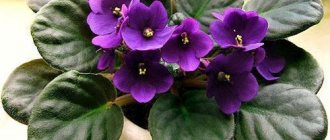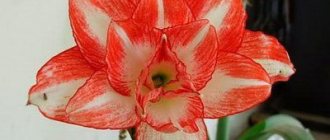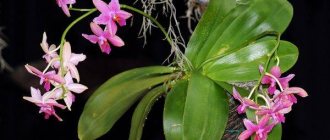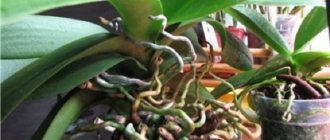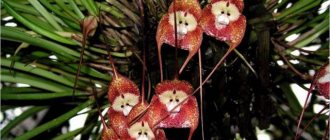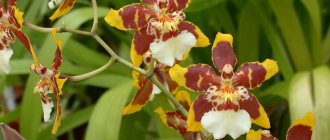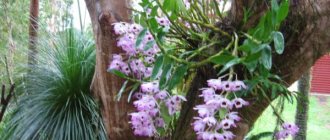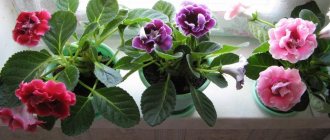In recent years, every self-respecting gardener has added epiphytes to his collection, namely orchids. It often happens that after purchasing one standard, more and more new types and colors of this plant gradually appear in the house.
Many people begin to grow only these flowers, which can create an exotic corner in the house with their unusual flowering. Orchids have a wide variety of flower colors, the range of shades is very rich, especially “black” orchids.
Phalaenopsis Kaoda
Phalaenopsis Kaoda is classified as an epiphyte with dark-colored flowers. If you study this color more precisely, it becomes clear that true black colors do not exist. Phalaenopsis lacks a gene that can create such a pigment for a flower.
The color is achieved due to the saturation of dark burgundy and lilac colors, and if the standard also has a light lip, then the contrast immediately makes it wishful thinking.
Phalaenopsis variety Kaoda has a unique flower color, a rich purple hue creates a visual illusion; the flowering trunk seems to have almost black flowers. The effect is enhanced by a white lip, which especially contrasts on the dark petals.
Most species have a light, barely perceptible odor , which is especially noticeable in the morning and evening hours. An increase in odor is also observed with increasing humidity around the trunk.
During the flowering period, the trunk usually pleases with two peduncles at once, on which medium-sized flowers are placed tightly together.
History of origin
The Kaoda orchid, the description of which was discussed above, appeared several years ago. The plant was first discovered by Professor Karl Brume. Since this type of orchid was seen at night, the professor mistook them for butterflies, which is why this name appeared.
It was possible to make an orchid home only several decades after their discovery. Kaoda is a natural variety, but thanks to the work of breeders in crossing, new varieties of flowers have appeared.
Existence in nature
The homeland of all phalaenopsis is considered to be the South and East of the Asian continent, as well as the north of Australia and all the islands located between them. Kaoda comes from Malaysia, namely from the islands of this archipelago. Nowadays, local residents still observe this curiosity in its natural environment, among stones and other exotic plants of the local flora.
Under natural conditions, the standard may have lighter colors, including light burgundy, lilac, and lilac.
External characteristics
Before you go to the store to buy, it’s worth learning a little more about the species itself:
- the height of the stem in the pot together with the peduncle is maximum 70 cm;
- an adult plant with proper care has five to six dark green leaf blades;
- peduncles come in different heights, maximum length 60 cm;
- the flower has a regular shape with symmetrical petals, each of them can reach 7-8 cm in diameter.
The color intensity of this stem is not always achieved with saturated colors; the density of the petals enhances the shade.
Photo of Phalaenopsis Kaoda.
Phalaenopsis Kaoda will look especially elegant on a snow-white windowsill, next to trunks of lighter shades. They will set off each other in the best possible way; playing in contrast will add its own flavor to your interior.
Subsorts with photos
Let us describe the two most common types of Kaoda orchid.
Chocolate drops
This type is translated as drops of chocolate. The plant has earned its popularity due to its very pronounced aroma and shade. The petals have a dark purple hue, the flower itself reaches a diameter of 5-7 centimeters. And the leaf plates are not very large - only 15 centimeters in length, but at the same time strong and elastic.
Twinkle
From a foreign language this name is translated as “flicker”. The color of the flowers is also very bright and rich, but burgundy in color. The stem can grow up to 20 centimeters, and the leaves are slightly larger - up to 22-25 cm. This subvariety does not differ in its bright aroma.
The video shows an overview of the Kaoda Twinkle orchid variety:
Bloom
The standard will delight you with flowering regularly. To do this, just follow simple rules:
- adhere to the necessary watering rules;
- Avoid exposure to direct sunlight;
- in the autumn-winter period, “increase” daylight hours using special lamps;
- feed moderately.
Only after this, at the beginning of spring, Kaoda will release an arrow or two , on which, after some time, flowers of rich color will gradually begin to bloom.
The flowering period can last from 2 to 5 months , everything will depend on external factors and the microclimate surrounding the tree.
Kaoda can bloom for up to 5 months.
After the last flower fades and falls, do not rush to cut off the arrow. Over time, new branches with buds may begin to develop from it.
What to do if it doesn't bloom?
Flower buds do not always bloom. They can remain dormant for quite a long time, waiting for ideal conditions to bloom. In this case, it is necessary to understand how correctly the crop is grown.
You need to check the following:
- Is there enough moisture or is it in excess? And solve the issue with proper watering.
- Does the flower get enough sunlight? If there is a deficiency, it is worth rearranging the pot.
- Are there enough minerals? Fertilize to stimulate the flowering process.
- Is the temperature optimal? It is necessary that the air warms up to +22…+27 degrees.
These are the basic requirements that you need to take care to comply with. By eliminating the factor that prevents the buds from blooming, you can enjoy the beautiful flowering of the orchid. If you continue proper care, it can last several months.
Landing
The Kaoda orchid has some features when transplanting a trunk:
- when choosing a pot for a plant, it is better to choose containers made of transparent plastic; they will allow you to monitor the condition of the root system and tell you when the next replanting is necessary;
- The soil for planting is not suitable for everyone; even a universal substrate for orchids will not satisfy all the needs of the plant. It would be ideal to fill the pot with medium pine bark or coconut chips;
- The trunk is replanted every two years, the main indicator being the filling of the container with roots. If they begin to occupy more than ¾ of the total volume, it’s time to change the pot.
Advice! If the water for irrigation is hard and settling does not help much, you can add pieces of sphagnum or peat to the substrate, this will prevent rapid alkalization of the soil.
Features of growing in a pot
If you plan to grow Kaodu Twinkle in a pot, then it is important to choose the right container. Thus, the pot must be transparent, since the root system is involved in the process of photosynthesis, with a diameter of no more than 15 cm.
It is best to purchase a ready-made substrate, intended specifically for growing orchids. The plant needs to be watered as the soil dries out. It is important to consider that the orchid is a tropical flower, so the air is required to be moist.
Advice! If necessary, you can see what the Kaoda orchid looks like in the photo.
Care
In order for the trunk to grow, develop and delight the eye with flowering, it is necessary to provide it with good conditions under which the plant will feel its best:
- Observe temperature conditions . Summer daytime temperatures should be between 20-24 degrees, at night this figure should drop to 18. In winter and autumn, 17 degrees is enough for Kaoda phalaenopsis;
- Watering should be moderate, it is important not to flood the trunk, but scanty watering can have a detrimental effect on the flower. The determining factor should be the air temperature: the higher it is, the more often we water. In winter, watering is reduced; at the proper temperature, it is enough to do this once every 10-14 days;
- Humidity The orchid will need high, spraying from a spray bottle should become regular. It is important not to get on the buds and flowers during the procedure;
Spraying an orchid with a spray bottle.
- Feed the plant regularly twice a month with complex fertilizer for orchids. Before flowering during the budding period, the use of fertilizers for epiphytes, which is sprayed directly on the leaves of the trunk, will have a good effect on the trunk. When the flowers begin to bloom, fertilizing is minimized; just once a month is enough for Kaoda to continue to bloom.
Most often, the plant suffers from diseases such as furaziosis and gray rot ; they usually arise due to improper watering; the flower is simply flooded. For treatment, all affected areas are cut off, the sections are processed and watered several times with the addition of antifungal drugs.
Of the pests, Phalaenopsis Kaoda is most susceptible to thrips and spider mites ; it is from them that you should protect your pet. If pests have settled on it, then use insecticides to combat them .
Advice! After flowering has finished, you can get a baby from the peduncle.
You can stimulate the flowering of a plant by using a difference in day and night temperatures, as well as by reducing watering.
Keeping at home
Kaoda is a rather capricious plant, but if a number of simple conditions are met, care will not be difficult.
- Favorable temperatures will ensure good development and lush flowering. The temperature in summer can be 20 - 28 degrees, in winter - 16 - 22. Deviation from the comfortable temperature in five to six days will cause the death of the plant.
- Lighting . The Kaoda pot should be placed on the eastern and western windowsill. Daylight hours should last at least 10 - 12 hours. The sun's rays scatter. In winter, a fluorescent lamp will provide the necessary lighting. For symmetrical growth, the pot needs to be rotated sometimes.
- Watering the substrate is carried out if necessary, it is judged by the condition of the roots and soil. Dry roots turn gray. The soil may remain dry for several days. Watering is carried out by irrigation and soaking in the morning. In winter, moisture is reduced.
- The air humidity in the room where the plants are located should be above 45%.
- feed every two weeks during the growth period. Fertilizers are applied together with watering.
- Pruning an orchid at home is carried out during resuscitation or after flowering. The operation is performed with a sharp and sterile pruning shears. The sections are treated with activated carbon.
- Replanting is necessary when filling the pot with roots. Replanting must be done every two years. The humidity in the room where the transplant is carried out should be about 60%, 25 degrees.
- The flowering period lasts 3 – 9 months. An adult orchid produces from 1 to 5 flower stalks. During this period, feeding and cutting arrows is prohibited.
- If Kaoda does not bloom , this indicates a lack of temperature difference. Day and night the difference should be 4 - 6 degrees. Reducing watering and stopping fertilizing for 3 to 4 weeks in winter can stimulate vigorous flowering.
Problems during cultivation
In general , Phalaenopsis Kaoda is not picky; it is grown in the same way as other types and varieties of orchids.
Problems arise only when the trunk is flooded or, conversely, its root system is dried out. Because of this, the plant begins to wither, shedding leaves, buds, and flowers.
The reason for this behavior of the trunk can also be a high dose of fertilizer.
How to reproduce?
Kaoda reproduces in the same way as other representatives of this family:
- dividing the bush;
- basal children;
- cuttings;
- children on a peduncle;
- seeds.
The flower takes quite a long time to recover, so it is worth dividing the bush or taking a cutting not during flowering. But growing from seeds is only available to specialists. This process requires a lot of patience and certain skills. In addition, the germination rate is very low as ideal conditions are required. Even professional flower growers prefer to buy a ready-made flower in a store or propagate it in other ways.
Kaoda twinkle
The phalaenopsis Kaoda twinkle orchid variety is special; it is classified as “black” because of the rich color of the petals. But the distinctive feature is something else - the variety has a white lip, which looks especially elegant against the dark background of the flower and thereby enhances the contrast.
The trunk lives and develops for 6-8 years, and begins to bloom 2-3 years after separation from the mother plant.
Advice! Don’t be alarmed if the flowers are a little small when they first bloom, just during the dormant period you should slightly increase the dose of fertilizer.
Kaoda Twinkle.
Replanting will be required only when the roots fill the entire pot. It is worth paying special attention to It is the freely decomposed roots that will become the key to the normal development and regular flowering of the trunk. In crowded conditions, the plant may simply grow ground greens or stop development altogether.
The standard no longer has any special features when growing, care is also standard. It is photophilous, but it is better to protect it from direct sunlight in the spring.
Diseases and pests
The main problems that flower growers will sooner or later have to face:
- Spider mite. You can only get rid of it with a hot shower and acaricides. Fitoverm is considered the least harmful.
- Rotting. Appears due to excess moisture. The plant must be replanted, but before doing this, remove traces of rot and dry the leaves and roots.
- Aphids, slender mites and whiteflies are destroyed using industrial poisons.
Reference. If the leaves become less dense or begin to turn yellow, reduce watering. Leaf fall is associated with low air humidity. Rot only appears if it is not properly cared for. You need to re-read the rules for growing orchids and compare them with your own actions.
Kaoda is a very rare variety of orchid. It is difficult to find in the store and is more expensive than other varieties. The flower requires special care. If the gardener already grows such crops, Kaoda can become the pearl of the collection. However, for beginners it is better to start with less rare and finicky varieties. The peculiarity of the subspecies is that it is very sensitive to external factors. Until the beginner determines what is preventing the orchid from growing normally, it will die.
5 / 5 ( 1 voice )
Rejuvenation
Sometimes it happens that orchids lose their growing point, after which the trunk may begin to rot, which can even lead to the loss of the trunk. How to avoid this and rejuvenate phalaenopsis if it has an empty trunk?
It is for this reason that the flower stalks are not removed after flowering ; the children can be awakened from the dormant buds on them. This is a protracted matter, so if you decide to do this, you should be patient. If luck is favorable to you, then the trunk can expel the sprout on its own; this mainly happens near the roots and is called a root shoot.
Both sprouts should develop in tandem with the old trunk, and only when the babies have 3-4 full leaves, and at least 2 aerial roots are attached to them, can they be carefully separated and planted in a separate container.
Transplantation and propagation
It is noted that the orchid develops well if it is free in the pot, so it is recommended to replant it after two years. The need for replanting can be judged by how full the pot is with roots. At home, to propagate the Kaoda orchid, you can use the lateral shoots on the peduncles or stems. During the procedure, 60% humidity and a temperature of +25°C must be maintained.
For separation you need to choose an orchid:
- with large leaves;
- healthy;
- with excellent root.
The procedure should be carried out after the flower has faded, but the peduncle should not yet dry out. On it, with a sharp tool, you should cut off the top of the head to the dormant bud located at the top.
Plant the freshly cut shoot in a small greenhouse with a substrate prepared in advance. Do not water for several days. Sprinkle the cut area with charcoal. You need to use a sharp instrument well disinfected with alcohol.
